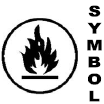

Hazard/Danger
Material will burn or spontaneously ignite in air, or give off flammable gas on contact with water
May ignite if exposed to flames, sparks, heat, friction
Flash Point
Lowest temperature that a liquid/solid gives off
enough vapour to explode/ignite if in contact with an
ignition source.
Lower Explosive Level (LEL)
Lowest concentration of a gas/vapour that will
explode/ignite when in contact with an ignition
source.
Static Electricity
Electric charge developed by unlike materials
contacting and separating from each other - controlled by bonding and
grounding.
Upper Explosive Level (UEL)
Highest concentration of a gas/vapour that will explode/ignite when in
contact with an ignition source
Divisions of Class B
(all use same symbol)
Reactive Flammable
Can spontaneously burn when in
reacts with water, or reacts with
water to give off a flammable gas.
Keep reactive flammable materials dry and away from oxidizers (including isolation from air).